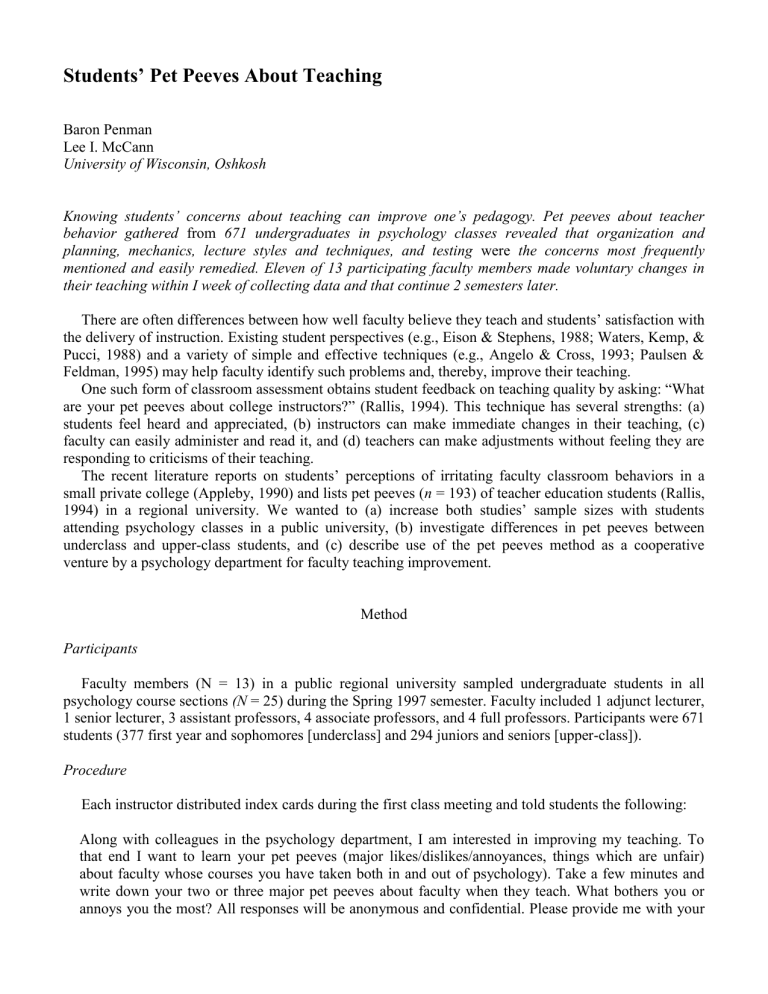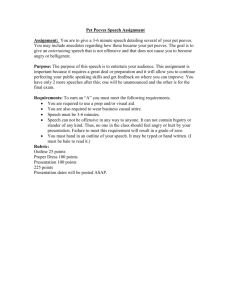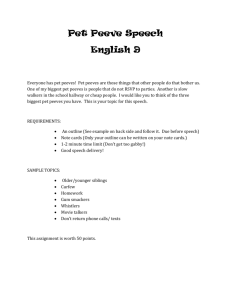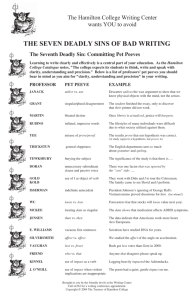Students’ Pet Peeves About Teaching

Students’ Pet Peeves About Teaching
Baron Penman
Lee I. McCann
University of Wisconsin, Oshkosh
Knowing students’ concerns about teaching can improve one’s pedagogy. Pet peeves about teacher behavior gathered from 671 undergraduates in psychology classes revealed that organization and planning, mechanics, lecture styles and techniques, and testing were the concerns most frequently mentioned and easily remedied. Eleven of 13 participating faculty members made voluntary changes in their teaching within I week of collecting data and that continue 2 semesters later.
There are often differences between how well faculty believe they teach and students’ satisfaction with the delivery of instruction. Existing student perspectives (e.g., Eison & Stephens, 1988; Waters, Kemp, &
Pucci, 1988) and a variety of simple and effective techniques (e.g., Angelo & Cross, 1993; Paulsen &
Feldman, 1995) may help faculty identify such problems and, thereby, improve their teaching.
One such form of classroom assessment obtains student feedback on teaching quality by asking: “What are your pet peeves about college instructors?” (Rallis, 1994). This technique has several strengths: (a) students feel heard and appreciated, (b) instructors can make immediate changes in their teaching, (c) faculty can easily administer and read it, and (d) teachers can make adjustments without feeling they are responding to criticisms of their teaching.
The recent literature reports on students’ perceptions of irritating faculty classroom behaviors in a small private college (Appleby, 1990) and lists pet peeves ( n = 193) of teacher education students (Rallis,
1994) in a regional university. We wanted to (a) increase both studies’ sample sizes with students attending psychology classes in a public university, (b) investigate differences in pet peeves between underclass and upper-class students, and (c) describe use of the pet peeves method as a cooperative venture by a psychology department for faculty teaching improvement.
Method
Participants
Faculty members (N = 13) in a public regional university sampled undergraduate students in all psychology course sections (N = 25) during the Spring 1997 semester. Faculty included 1 adjunct lecturer,
1 senior lecturer, 3 assistant professors, 4 associate professors, and 4 full professors. Participants were 671 students (377 first year and sophomores [underclass] and 294 juniors and seniors [upper-class]).
Procedure
Each instructor distributed index cards during the first class meeting and told students the following:
Along with colleagues in the psychology department, I am interested in improving my teaching. To that end I want to learn your pet peeves (major likes/dislikes/annoyances, things which are unfair) about faculty whose courses you have taken both in and out of psychology). Take a few minutes and write down your two or three major pet peeves about faculty when they teach. What bothers you or annoys you the most? All responses will be anonymous and confidential. Please provide me with your
class standing and whether you have done this exercise in another class during the last few days.
Faculty members collected cards, thanked students, read their comments, and gave the cards to the authors.
Table 1 shows Rallis’s (1994) categories and new ones (we added) to encompass all the responses.
Students listed between zero and five pet peeves. Some provided two or more different responses for a single category. To avoid duplication, we discarded cards from students who had participated in previous classes.
Results and Discussion
Student Pet Peeves
Despite some differences in data collection methods from Appleby (1990) and a different sample from both Appleby and Rallis (1994), students identified similar pet peeves about irritating faculty behaviors.
Chi square analyses comparing the ratio of pet peeves from underclass and upper-class students in each category to each group’s total responses were nonsignificant, signifying that student concerns apply to courses at all undergraduate levels. Six underclass and 4 upper-class students listed no peeves.
Table 1 categorizes 1,455 responses; 944 (65%) fell in one of the “teaching” categories, most emphasizing poor organization and planning, teaching mechanics, lecturing, testing procedures and exams, or a monotone voice. Some complained exams cover only the text and others only the lecture, others about use or nonuse of grading curves, or requiring or not requiring attendance. Obviously, teachers cannot please everyone.
“Respect” elicited 151 peeves (10%) and the “general” category elicited 265 peeves (18%). Lack of respect for students and poor use of class time elicited the most concerns.
Positively, few faculty members seemed to demonstrate a lack of interest, competence, or depth in their subject or teaching, and most seemed to grade fairly. Students rarely complained about too much work, sexism, or racism.
Table 1. Student Pet Peeves About Teaching
Teaching
Poor organization/planning
N
253
% a
17
Poor teaching mechanics (e.g., speak too
fast/slow/softly, poor use of board)
Lecture style and technique
Poor testing procedures/exams
Monotone voice
Grading process
Lack of interest/competence/depth, lack of course content
Unfair grading
Inappropriate humor
207
154
121
81
50
36
24
15
944
14
11
8
6
3
2
2
1
65 Total
Respect
Intellectual arrogance/talk down
Don’t respect students
44
42
41
3
3
3 Not approachable, unhelpful
Control/impose views
Intolerant of questions
Total
General
Total
Negative mannerisms
Poor use of class time (coming late, stopping early)
Not in during office hours/hard to find
Poor syllabus
Forced class participation
Insensitive to students time constraints
Too much work
Don’t relate material to real life
Bias/sexism/racism
Other
Negative mannerisms (e.g., attire, vocal, and nonverbal
16
8
151
76
35
33
28
25
20
12
2
34
265
95
1
1
10
5
2
2
2
2
1
1
0
2
18
7
mannerisms)
Overall total 1,455 100
Note. Responses represent number of peeves. Students sometimes gave two different peeves coded into a single category. Total percentage may not equal sum of item percentages due to rounding. a Percentage of number of peeves to the total (N = 1,455).
Of the many peeves (n = 95,7%) in the negative mannerism category, a few were humorous
(e.g., bad haircuts and wardrobes, sloppy dresser). Many simple peeves regarding vocal (e.g., repetitive verbal mannerisms such as “uhs”) and nonvocal mannerisms (e.g., walking around too much) would, if remedied, easily improve teaching or the perception thereof.
Faculty Changes in Teaching
Of the 13 faculty participating, 11(85%) made teaching changes during the first week of classes; all have maintained these changes two semesters later. Changes included enhancing lectures with more overheads, greater sensitivity to scheduling reading and assignments, extra care reviewing pr evious classes, reducing pauses (“uh”) in lectures, a brief break in a 90 mm class, more clarity in grading criteria, slower speech, and arriving to class earlier. Future research could investigate the differential effectiveness of student evaluations, peer review, and the pet peeves technique in facilitating changes in faculty teaching.
The study has limitations. The data represent a single public regional university campus with few minority students.
Lessons Learned
1. The concerns in Table 1 provide a starting point for improving instruction for any teacher.
2. Students know good teaching and are sensitive to not receiving it.
3. This is a simple technique faculty can use to improve pedagogy. If faculty wish, they can easily remedy many identified teaching concerns.
4. The lack of significant differences between underclass and upperclass students’ peeves means instructors teaching improvements need not be made differentially for lower- or upper-level undergraduate courses.
5. Separating evaluation of teaching for summative purposes (e.g., personnel decisions) from the formative purpose of improving one’s pedagogy encourages faculty to become better teachers by responding to student concerns. Our colleagues at all ranks embraced improving their teaching willingly and energetically.
References
Angelo, T. A., & Cross, K. P. (1993). Classroom assessment techniques: A handbook for college teachers (2nd ed.). San Francisco:
Jossey-Bass.
Appleby, D.C. (1990). Faculty and student perceptions of irritating behaviors in the college classroom. Journal of Staff, Program, arid Organization Development, 8, 4146.
Eison, J., & Stephens, J. (1988). Elements of instructional excellence: The views of university honors and non-honors students. Forum for Honors, 18,3547
Paulsen, MB., & Feldman, K. A. (1995). Taking teaching seriously:
Meeting the challenge of instructional improvement (ASHE-IFRIC Higher Education Rep.
No.2). Washington, DC: George Washington University, Graduate School of Education and
Human Development.
Rallis, H. (1994). Creating teaching and learning partnerships with students: Helping faculty listen to student voices. To Improve the Academy, 13,155 —168.
Waters, M., Kemp, E., & Pucci, A. (1988). High and low faculty evaluations: Descriptions by students. Teaching of Psychology, 15,
203
—204.
Notes
1. This article is based on a poster presented at the 1998 Annual National Institute on the
Teaching of Psychology, St. Petersburg Beach, FL.
2. We acknowledge the assistance of our students and departmental colleagues.
3. A handout with examples of student pet peeves from the “teaching,” “other,” and “negative mannerisms” categories is available from the authors.
4 . Send correspondence to Baron Perlman, Department of Psychology, University of Wisconsin
Oshkosh, Oshkosh, WI 54901; e-mail: Perlman@uwosh.edu.


